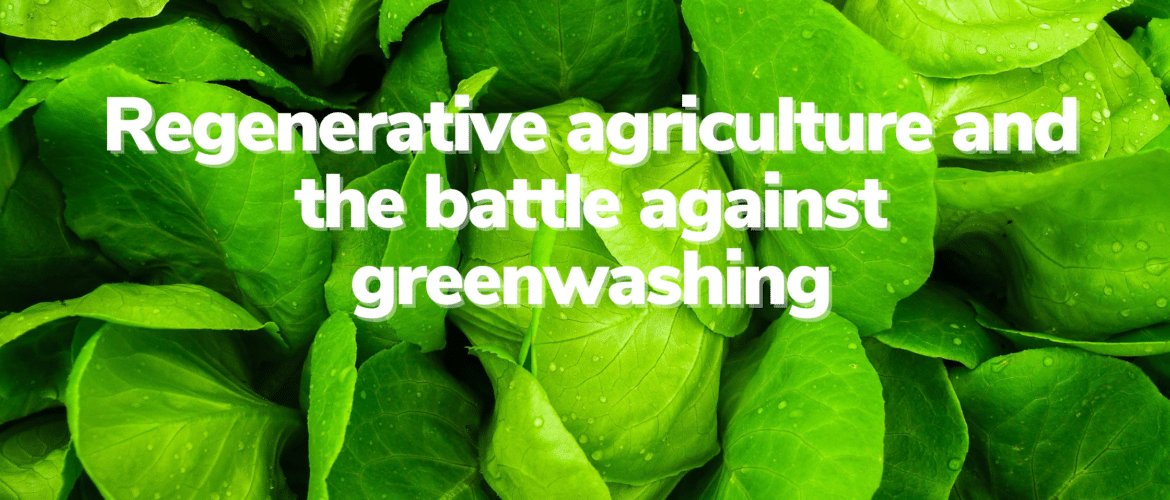
Regenerative agriculture and the battle against greenwashing
An article by Andrew Ardington, founder of the Regenerative Agriculture Association of Southern Africa, highlights how regenerative agriculture can’t be minimised into a tick-box activity or a marketing opportunity rather than a genuine effort to restore ecosystems. While there is no official definition of regenerative agriculture, it is crucial for any claims of being “regenerative” to demonstrate improvement or maintenance of soil health.
We read the article with a resounding ‘yes’, so we decided to catch up with Ardington to explore the parallel between regenerative greenwashing and the current wave of scepticism towards ESG (Environmental, Social, and Governance) investment greenwashing. This connection raises crucial questions about the credibility of regenerative agriculture in the face of mounting concerns about greenwashing.
Challenges and perceptions of ESG investing
Ardington acknowledges the complexity of ESG investing. He points out that much like regenerative agriculture, ESG is challenging to measure, a characteristic that sets it apart from more straightforward metrics like a company’s audited accounting performance. The nebulous nature of ESG, with its emphasis on intangible, “touchy-feely” aspects, has led to some investors viewing it as a distraction from a company’s core business. This sentiment, Ardington argues, is one reason why some are hesitant to fully embrace ESG. “ESG is another thing they have to add; it’s very difficult to measure, which in some ways makes it like regenerative agriculture,” he says.
The prevailing sentiment among investors, Ardington notes, is an aversion to laws and regulations dictating performance. There is a tendency to wish these concerns away, hoping they’ll cease to be a focal point. This sentiment aligns with the attitude towards carbon credits, where many companies would prefer to avoid grappling with the complexities of carbon neutrality and credit purchases. It’s tempting to delegate these responsibilities to governments, but Ardington cautions against overburdening them, emphasising that we all share one planet, one that transcends national borders: “Investors, bankers, whoever, they don’t like any laws and regulations (none of us do) that come along and tell us how we must perform.”
How might this resistance to ESG impact the ability of regenerative agriculture to deliver on its promise?
Ardington draws a line of distinction when it comes to the credibility of regenerative agriculture. He posits that the backlash against ESG and carbon credits is more akin to the resistance against greenwashing. Regenerative agriculture, with its profound potential, is not intrinsically tied to the complexities of ESG. While it may have indirect involvement with certain companies, it stands apart as a solution urgently needed for the environment and society. “I don’t really see it as being a parallel with the credibility of regenerative agriculture. I see it more as a parallel with carbon credits,” he says.
Ardington posits that there is indeed a space for the ethical implementation of carbon credits. He notes that, like ESG, there are specific parameters within which these financial instruments operate. He cautions against circumventing these guidelines, stressing the importance of ensuring that carbon credits serve their intended purpose and do not devolve into a black market. “Carbon credits are suffering a little bit from that at the moment that people feel that they have to share an unfair burden of the cost of carbon credits,” he says.
Making regenerative agriculture a reality
Ardington says that regenerative agriculture has two fundamental facets: the economic aspect, focused on rectifying farm economics, and the environmental aspect, vital for global well-being. The environmental side encompasses vital cycles, notably the carbon and water cycles, which are foundational to life on Earth. Ardington underscores that these functions cannot be replicated in a lab; they hinge on cultivating healthy, functional soil.
But who’s in charge here?
Considering the stakeholders in the agricultural value chain, Ardington emphasises that change cannot be driven from the bottom up. Rather, it necessitates a holistic transformation involving all players, from retail to producers, processors, and farmers. This shift, he suggests, demands a long-term plan, perhaps spanning a decade, and open, transparent communication with consumers and stakeholders. In contemplating the pivotal question of who should spearhead these initiatives, Ardington advocates for a public-private partnership. This approach, he believes, is best suited to navigate the challenges posed by the private sector while ensuring accountability and effectiveness.
What happens if we don’t act now?
Ardington underscores that the economic landscape of agriculture is already undergoing rapid shifts, with small and medium-sized farms giving way to larger operations due to diminishing profits per hectare. This consolidation, while seemingly a solution, brings its own set of challenges, including economic strain on local communities: “Everybody involved in industrial agriculture for agricultural economies is having the same experience where the small and medium-sized farms are going out of business, and the land has been bought up by the bigger farms.”
Ardington emphasises that the ramifications extend beyond economics, affecting society at large. The environment, intricately linked with agriculture, stands to suffer if regenerative practices are not embraced. Climate variability, water scarcity, and ecological instability are looming threats if we do not take decisive action. “We can’t really live on this planet if those things aren’t functioning, and you can’t fix them in a lab. You’ve got to fix them by fixing the soil and having good functional soil.”
Yet, Ardington offers a glimmer of hope. “What gives me great hope, when I think about these very difficult situations that we’re in, is the incredible speed with which soil health returns to soil. In just three years, the entire functioning of a soil can change”. This demonstrates that positive change is within reach. While wild claims about the capabilities of regenerative agriculture may be imprudent, there is an undeniable urgency to embrace its principles for the betterment of our planet and our collective future.
ABOUT REGENAG SA
The Regenerative Agricultural Association of Southern Africa (RegenAg SA) is a nonprofit education and advocacy organisation that is working to stop the catastrophic consequences of Industrial Agriculture by facilitating farmers and consumers in transitioning to Regenerative Agriculture.
https://www.regenagsa.org.za/
